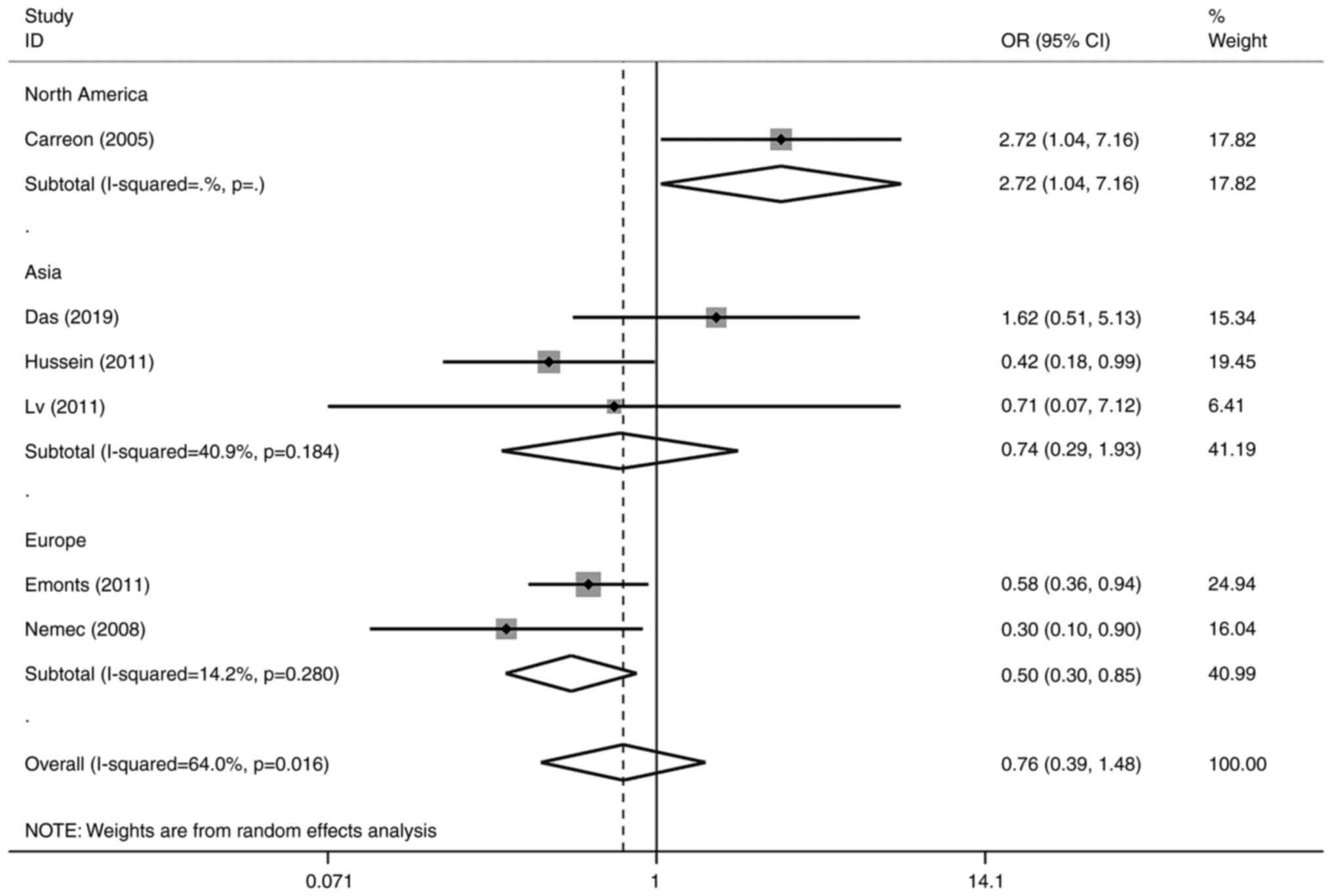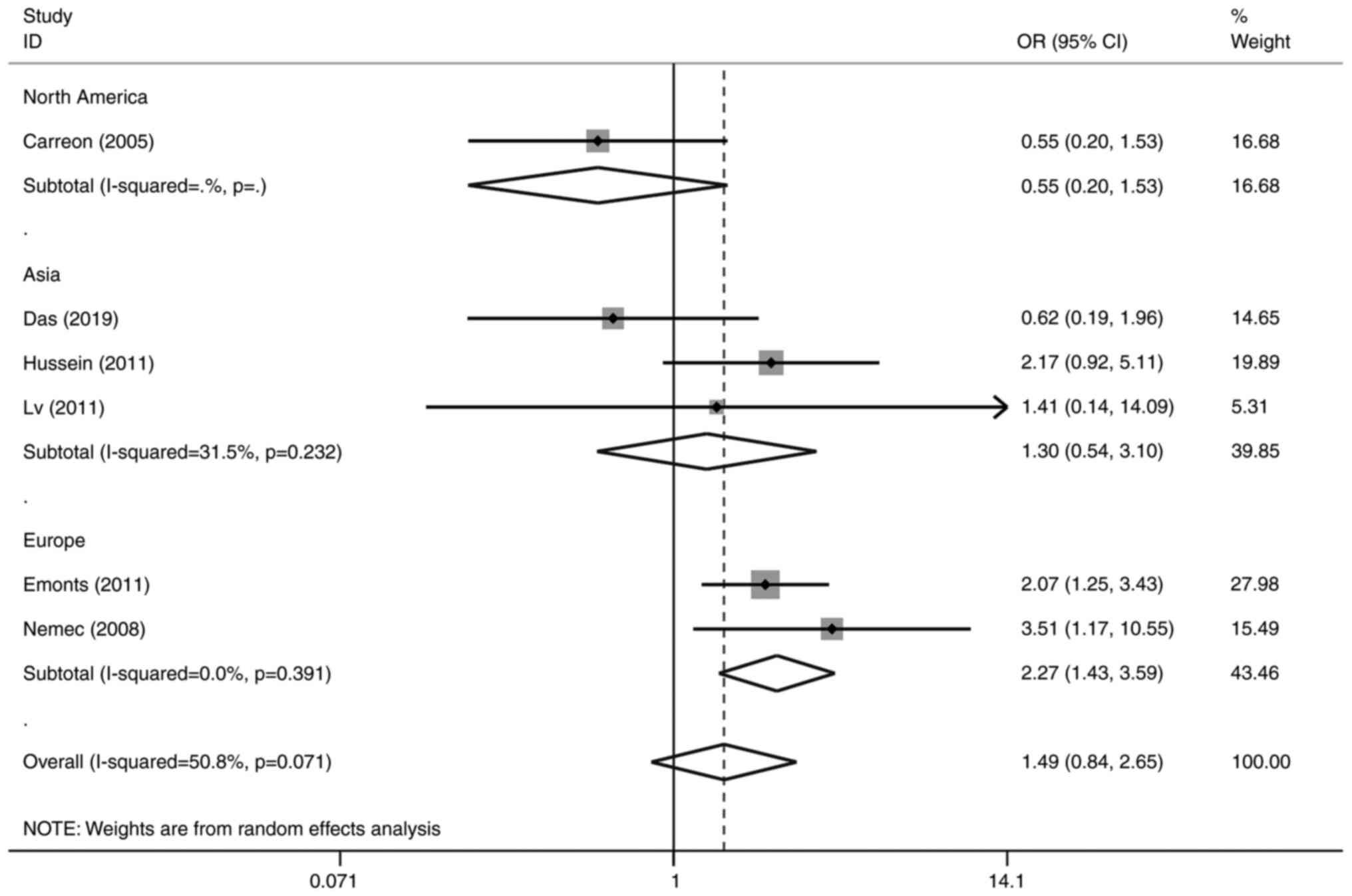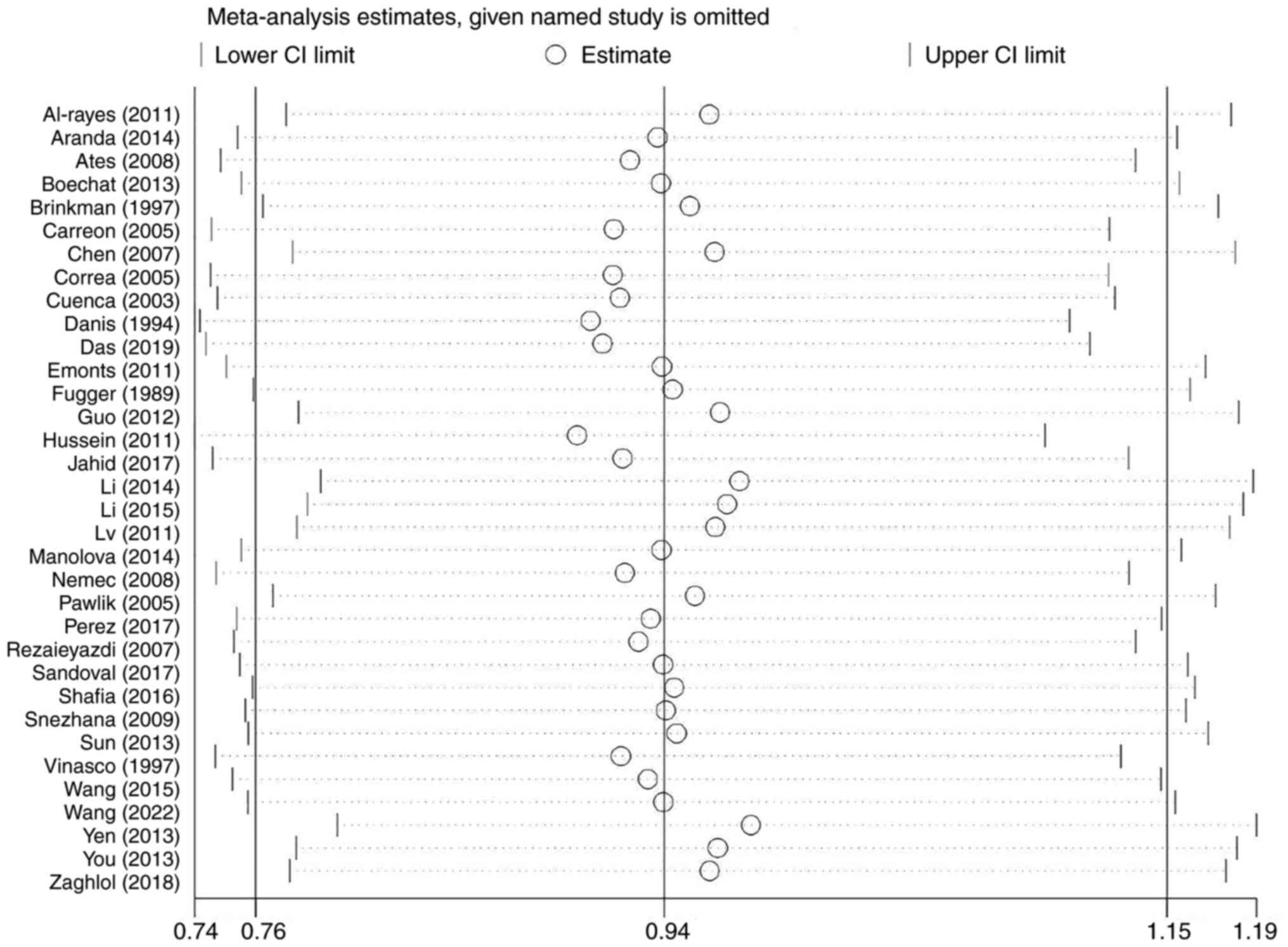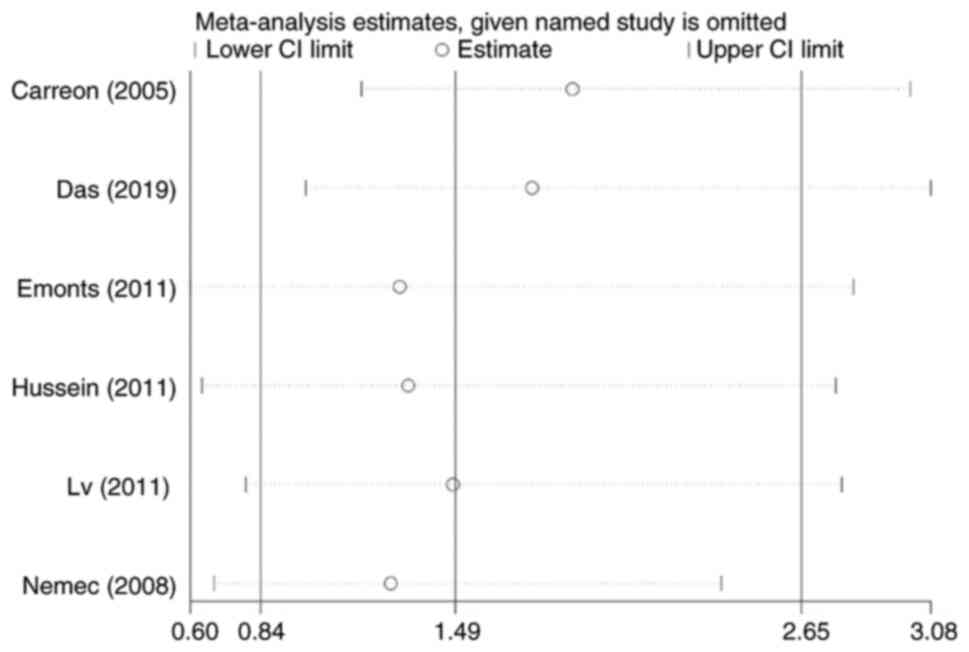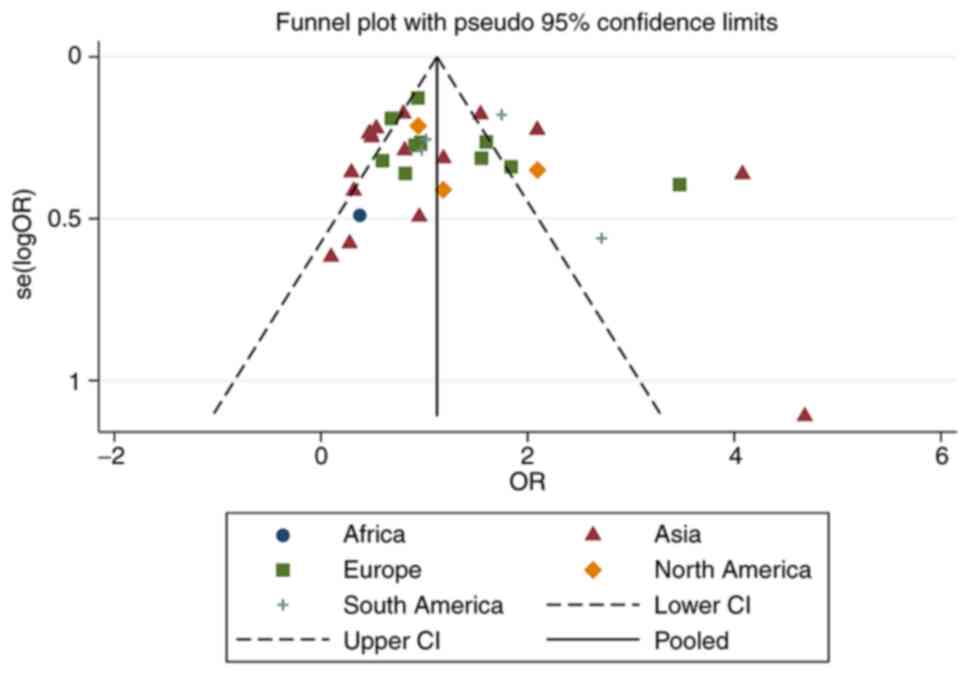Evaluation of genetic polymorphisms in TNF‑α‑308G/A rs1800629 associated with susceptibility and severity of rheumatoid arthritis: A systematic review and meta‑analysis
- Authors:
- Published online on: May 13, 2024 https://doi.org/10.3892/etm.2024.12567
- Article Number: 279
-
Copyright: © Wang et al. This is an open access article distributed under the terms of Creative Commons Attribution License.
Abstract
Introduction
Rheumatoid arthritis (RA) is a common, chronic autoimmune joint disease characterized by synovial inflammation, pannus formation and joint damage as major pathological features. The global incidence of RA is 0.5-1% (1). RA is characterized by chronic systemic inflammation, which mainly affects the joint synovial tissue, eventually leading to joint destruction, functional disability and even death, severely affecting the quality of life of patients (2). The etiology and pathogenesis of RA remain largely unknown. Currently, it is considered by most scholars that this is the result of the combined effects of genetics, environment, infection and other factors, leading to an imbalance in immune regulation and the induction of a series of joint tissue inflammations (3). It has been hypothesized that TNF-α-308G/A rs1800629 is closely related to the pathogenesis and severity of RA (4,5), while other studies consider that there is no relationship between the two (6,7). Different studies produced different results (4-7), which may be related to the sample size, quality and whether the frequency of the control genotype conformed to the Hardy-Weinberg equilibrium (HWE) (8). Therefore, the current meta-analysis of the two aspects of susceptibility and severity of TNF-α-308G/A rs1800629 and RA was conducted to obtain reliable theoretical support and research results and provide evidence-based medical evidence for in-depth research on genetic susceptibility.
Materials and methods
Search policy
The PubMed (https://pubmed.ncbi.nlm.nih.gov), EMBASE (https://www.embase.com), Web of Science (https://www.webofscience.com/wos) and CNKI (https://www.cnki.net/) databases were employed. The key words searched were: ‘rheumatoid arthritis’, ‘TNF-α’ and ‘polymorphism’. The search strategy was as follows: (polymorphism or variant or variation or mutation or SNP or genome-wide association study or genetic association study or genotype or allele) AND (rheumatoid arthritis) OR (RA) AND (Tumor Necrosis Factor-alpha) OR (Tumor Necrosis Factor alpha) OR (Cachectin) OR (Cachectin-Tumor Necrosis Factor) OR (Tumor Necrosis Factor Ligand Superfamily Member 2) OR (Tumor Necrosis Factor) OR (TNFalpha) OR (TNF-alpha) OR (TNF-α). The search period ranged from the establishment of each database until May 2023.
Inclusion and exclusion criteria
The inclusion criteria were as follows: i) The study participants were patients with RA, and there were clear diagnostic criteria; ii) the type of study was a case-control study or a cohort study; iii) the research content was the relationship between TNF-α-308G/A rs1800629 gene polymorphisms and the susceptibility or severity of RA; iv) the study included complete genotype and allele frequency data and inclusion or availability to calculate odds ratio (OR) and 95% confidence intervals (CI); v) the control group conformed to HWE.
The exclusion criteria were as follows: i) Duplicate publications; ii) no health control studies; iii) studies with incomplete data or an inability to calculate OR and 95% CI; and iv) animal experimental literature.
Data extraction
Two authors independently screened and extracted the data; in cases of disagreement, a third author decided. Missing data were supplemented as much as possible by contacting the authors of the studies. The data extracted included: i) First author and year of publication; ii) country, geographic region, sex composition, mean age and diagnostic criteria of the study subjects; iii) sample size, allele and genotype frequency of the RA and control groups; and iv) whether they conformed to the HWE.
Literature quality evaluation criteria
The Newcastle-Ottawa Scale (NOS) evaluated the quality of the literature. The NOS scale includes three dimensions with a total of eight items: Four items for study object selection, one item for intergroup comparability and three items for outcome measurement. In addition to the comparability item, the highest score was two points, and the other items could reach up to one point, with a score range of 0 to 9 points. The higher the overall score, the higher the quality of the study. The NOS score is divided into three grades: Low, medium and high quality, namely <5 points, 5-7 points and ≥8 points (9).
Statistical methods
The present study was performed following the Preferred Reporting Items for Systematic Reviews and Meta-Analyses guidelines (10). The meta-analysis was performed using Stata 17.0 (StataCorp LP). Using OR and its 95% CI to assess the strength of the association between TNF-α-308G/A rs1800629 gene polymorphisms and the risk and severity of RA, P<0.05 was considered statistically significant. Heterogeneity was assessed using Cochrane's Q test and I2 values, and pooled analyses were performed using a random-effects model when I2≤50% between study groups. When heterogeneity could not be completely eliminated, a random-effects model was also used. The following five genetic models were used for comparison: Allele, dominant, recessive, co-dominant and super-dominant models. Subgroup analysis was carried out for further research. The subgroups were divided into: Asian, South American, European, North American and African groups according to the source of the patient. Sensitivity analyses were conducted by excluding literature on a case-by-case basis to observe the effect of each study on the overall effect size or by using Stata 17.0 to assess the robustness of the results. Funnel plots were only used to visualize publication bias for the number of included studies ≥10. Publication bias was detected using Egger's test, and no publication bias was considered when P>0.05(11).
Results
Search results
According to the search strategy, 1,862 relevant studies were retrieved from the databases, duplicate publications were removed, and 34 studies were screened in combination with the aforementioned inclusion and exclusion criteria. The study of TNF-α-308G/A rs1800629 gene polymorphisms and susceptibility to RA included 6,030 cases in the RA group and 6,581 cases in the control group. TNF-α-308G/A rs1800629 gene polymorphisms and the severity of RA included 483 cases in the RA group and 545 cases in the control group. The selection process and results of the included studies are demonstrated in Fig. 1.
Basic information included in the literature
The basic characteristics of the included studies and the NOS score results are presented in Table I. The specific sample size, genotype and allele frequency included in the study of TNF-α-308G/A rs1800629 polymorphisms and susceptibility to RA are shown in Table II. Of the studies included in the meta-analysis, 16 were conducted in the Asian population, four in the South American population, 10 in the European population, three in the North American population and one in the African population. The specific sample size, genotype and allele frequency included in the study of TNF-α-308G/A rs1800629 polymorphisms and the severity of RA are presented in Table III. Of the studies included in the meta-analysis, one was conducted in North Americans, three in Asians and two in Europeans.
Table IISample size, genotype and allele frequency in rheumatoid arthritis and control groups in susceptibility studies. |
Results of the meta-analysis. TNF-α-308G/A rs1800629 polymorphisms and susceptibility to RA
A total of 34 studies were included in the present analysis. Significant study heterogeneity was observed in allele, dominant and super-dominant models (I2≥50%, P<0.05); therefore, random-effect models were used for analysis. Other genetic models were less heterogeneous and were also analyzed using random-effect models (I2<50%, P>0.05). No significant association between TNF-α-308G/A rs1800629 gene polymorphisms and susceptibility to RA was observed in the five gene models (P>0.05). After subgroup analysis, no clear association was observed among the different geographic regions. Detailed data is listed in Table IV.
Table IVSummary of associations between TNF-α-308G/A rs1800629 gene polymorphisms and rheumatoid arthritis. |
TNF-α-308G/A rs1800629 polymorphisms and severity of RA. A total of six studies were included in the meta-analysis. Significant study heterogeneity was observed in allele models, dominant gene models and super-dominant models (I2≥50%, P<0.05); therefore, random-effect models were used for analysis. Recessive and co-dominant models were also analyzed using random-effect models. In the overall calculation, TNF-α-308G/A rs1800629 polymorphisms were not statistically significantly associated with the severity of RA. After subgroup analysis by geographic region, TNF-α-308G/A rs1800629 polymorphisms were significantly associated with RA severity in European populations, GA + AA vs. GG: (OR=0.503, 95% CI: 0.297-0.853 and P=0.011); GG + AA vs. GA: (OR=2.268, 95% CI: 1.434-3.590 and P<0.001). No other models were statistically significant. Forest plots of the dominant gene models and super-dominant models are illustrated in Figs. 2 and 3, and detailed data are revealed in Table V.
Table VSummary of associations between TNF-α-308G/A rs1800629 gene polymorphisms and rheumatoid arthritis. |
Heterogeneity and sensitivity analyses. Heterogeneity between the studies was observed in the current meta-analysis. Subgroup analyses were performed to explore the sources of heterogeneity. For the study of TNF-α-308G/A rs1800629 polymorphism and RA susceptibility, subgroup analysis by geographical region showed no significant statistical significance in the overall and subgroup results of the five gene models. For the study of TNF-α-308G/A rs1800629 polymorphisms and RA severity, the overall results of the five gene models were not statistically significant, but TNF-α-308G/A rs1800629 polymorphisms were observed to be significantly associated with the severity of RA in the European population after subgroup analysis; therefore, geographical regions may be the source of heterogeneity in TNF-α-308G/A rs1800629 polymorphisms and RA severity studies. In both studies, sensitivity analyses were performed using the two methods. First, a sensitivity analysis was conducted by eliminating them individually. The results showed no significant change in the OR or 95% CI values for the overall outcome after the sequential removal of each study. Second, Stata 17.0 software performed a sensitivity analysis of the results of the meta-analysis. The results revealed that none of the 34 studies on RA susceptibility affected the stability of the results (Fig. 4). Similarly, none of the six studies on the severity of RA affected the stability of the results (Fig. 5). The results of sensitivity analysis indicated that the present meta-analysis was reliable.
Analysis of publication bias. In the study of TNF-α-308G/A rs1800629 polymorphisms and susceptibility to RA, the funnel plot method was used to test for publication bias. A publication bias funnel plot, which is visually asymmetric, is illustrated in Fig. 6, and there may be bias. After the Egger method test, P>0.05 in all genetic models indicated that there was no publication bias in the present study, and the detailed data are presented in Table IV. For the study of TNF-α-308G/A rs1800629 polymorphisms and RA severity, no publication bias funnel was used for publication bias because the number of studies was <10. Publication bias was assessed using Egger's test. According to the results of the Egger test, P>0.05 in all genetic models indicated that there was no publication bias in the present study. Detailed data is listed in Table V.
Positive result confidence test. Based on the OR value and 95% CI of the aforementioned results, the false-positive report probability (FPRP) values of the dominant and super-dominant models were calculated under a series of prior probability conditions, and the results are shown in Table VI. An FPRP value of <0.2 was used as the standard to judge the reliability of the correlation (42). Confidence assessment determined that the statistically significant association in this meta-analysis was reliable for TNF-α-308G/A rs1800629.
Discussion
RA is a typical chronic inflammatory disease, and genetic factors are extremely important in the pathogenesis of RA. Individuals with predisposing genes are exposed to specific environments that cause immune regulation in the body, thereby triggering the entire inflammatory process. During this process, the oxidative stress that occurs in the body accelerates the inflammatory process, aggravates immune system disorders and promotes the occurrence of diseases (43). In addition, RA is a heterogeneous disease, and genetic and environmental factors influence its incidence in different ethnic groups. According to the current results, genetic heterogeneity is manifested by different susceptibility gene loci in different races, and even if individual sites are the same, allele frequency and genetic contribution are different (44).
The TNF-α gene, located in a highly polymorphic region, human chromosome 6 short arm 6p21.3, is a pro-inflammatory cytokine produced primarily by macrophages and monocytes and is involved in normal inflammatory and immune responses (45). TNF-α has two different receptors (TNFR1 and TNFR2). TNF-α binds to cell surface TNFR1 and TNFR2, respectively, to regulate apoptosis, proliferation and differentiation. Most cell surfaces express TNFR1; however, TNFR2 expression is limited to immune cells (46). TNF-α has numerous biological effects, such as activation, proliferative and differentiation of immune cells; inducing apoptosis in certain non-tumor cells and most tumor cells; playing an important role in antitumor, immune defense and inflammatory response; and is an important biological mediator for maintaining the immune balance of the body (47). TNF can be detected in the synovial fluid of patients with RA; therefore, it is important to investigate whether there is an association between TNF-α-308G/A rs1800629 gene polymorphisms and RA susceptibility and severity. The results of Jahid et al (4) demonstrated that TNF-α-308G/A rs1800629 was strongly associated with the onset of RA in the Indian population. Li et al (26) showed that TNF-α-308G/A rs1800629 gene polymorphisms were significantly associated with the occurrence of RA in the Han Chinese population. By contrast, the results of Sun et al (6) demonstrated that TNF-α-308G/A rs1800629 gene polymorphisms are not associated with the pathogenesis of RA. In addition, Boechat et al (5) reported through a controlled study of 131 patients with RA and 192 healthy volunteers that TNF-α-308G/A rs1800629 gene polymorphisms in the Brazilian population were not associated with the occurrence of RA but were related to the severity of the disease. Nemec et al (30) reported that patients with RA and the GG genotype of the promoter polymorphism of the TNF-α-308G/A rs1800629 had a more severe disease course. In addition, they observed that the G allele of the TNF-α-308G/A rs1800629 promoter polymorphism in this cohort was associated with decreased functional ability in patients with RA. In a previous meta-analysis, Song et al (48) included 19 studies suggesting that TNF-α-308G/A rs1800629 gene polymorphisms are associated with susceptibility to RA. This meta-analysis excluded the literature that the genotype frequency of the control group did not conform to HWE, included a total of 34 relevant literature, analyzed by five gene models, and finally reported that TNF-α-308G/A rs1800629 gene polymorphisms were associated with the severity of RA in the European population in the dominant model and the super-dominant model, and the results were reliable after FPRP testing.
The present meta-analysis had certain limitations. First, the current study included 34 articles, but the sample size of certain single nucleotide polymorphism analyses was small, and most of them were single-center studies. More high-quality, multicenter and large-sample studies are required for further analysis and verification. Second, a few studies did not provide long-term follow-up data, making it difficult to assess the durability and stability of the results. Thirdly, in the subgroup analyses, the sample sizes were insufficient for a few ethnic groups, resulting in a slight lack of diversity in the results. Fourth, only the relationship between TNF-α-308G/A rs1800629 gene polymorphisms and the susceptibility and severity of RA was studied, and further research on other related genes is necessary to fully elucidate the pathogenesis of RA. Fifth, meta-analysis is a descriptive secondary analysis that builds on existing research; therefore, the heterogeneity of the selected literature, study design of variables, different judgment criteria and statistical methods may affect the results of the meta-analysis.
In summary, it was observed that TNF-α-308G/A rs1800629 gene polymorphisms were not associated with susceptibility to RA. However, TNF-α-308G/A rs1800629 gene polymorphisms were significantly associated with the severity of RA in the European population, and FPRP testing suggested reliable results.
Acknowledgements
Not applicable.
Funding
Funding: No funding was received.
Availability of data and materials
The data generated in the present study are included in the figures and/or tables of this article.
Authors' contributions
YLW and XYL participated in the design of the present study, and both performed statistical analyses. LL and SFL conducted the study and collected important background information. PFH and XDL drafted the manuscript. All authors read and approved the final manuscript. Data authentication is not applicable.
Ethics approval and consent to participate
All procedures involving human participants performed in the present study were in accordance with the ethical standards of the institutional and/or national research committee and with the 1964 Helsinki Declaration and its later amendments or comparable ethical standards. For this type of study, formal consent was not required.
Patient consent for publication
Not applicable.
Competing interests
The authors declare that they have no competing interests.
References
|
Smolen JS, Aletaha D, Barton A, Burmester GR, Emery P, Firestein GS, Kavanaugh A, McInnes IB, Solomon DH, Strand V and Yamamoto K: Rheumatoid arthritis. Nat Rev Dis Primers. 4(18001)2018.PubMed/NCBI View Article : Google Scholar | |
|
Rosa-Gonçalves D, Bernardes M and Costa L: Quality of life and functional capacity in patients with rheumatoid arthritis-cross-sectional study. Reumatol Clin (Engl Ed). 14:360–366. 2018.PubMed/NCBI View Article : Google Scholar | |
|
Giannini D, Antonucci M, Petrelli F, Bilia S, Alunno A and Puxeddu I: One year in review 2020: Pathogenesis of rheumatoid arthritis. Clin Exp Rheumatol. 38:387–397. 2020.PubMed/NCBI View Article : Google Scholar | |
|
Jahid M, Rehan-Ul-Haq Jha PK, Chawla D, Avasthi RS and Ahmed RS: Tumor necrosis factor-α-308 polymorphism in North Indian rheumatoid arthritis patients and association with mRNA and serum TNF-α. Clin Rheumatol. 36:2209–2216. 2017.PubMed/NCBI View Article : Google Scholar | |
|
Boechat AL, Boechat Nde O, Ogusku MM, Alencar MR, Abensur Tda C, Cardoso Neto J, Amorim Lde S, de Oliveira LM, Sadahiro A and Dos-Santos MC: The influence of a TNF gene polymorphism on the severity of rheumatoid arthritis in the Brazilian Amazon. Cytokine. 61:406–412. 2013.PubMed/NCBI View Article : Google Scholar | |
|
Sun R, Huang Y, Zhang H and Liu R: MMP-2, TNF-α and NLRP1 polymorphisms in Chinese patients with ankylosing spondylitis and rheumatoid arthritis. Mol Biol Rep. 40:6303–6308. 2013.PubMed/NCBI View Article : Google Scholar | |
|
Cadena-Sandoval D, Alemán-Ávila I, Barbosa-Cobos RE, Becerril-Mendoza LT, Fragoso JM and Ramírez-Bello J: Tumor necrosis factor (TNF) and TNFR1 polymorphisms are not risk factors for rheumatoid arthritis in a Mexican population. Mol Biol Rep. 45:227–232. 2018.PubMed/NCBI View Article : Google Scholar | |
|
Zheng G, Zhang W, Xu J, Yuan A, Li Q and Gastwirth JL: Genetic risks and genetic model specification. J Theor Biol. 403:68–74. 2016.PubMed/NCBI View Article : Google Scholar | |
|
Stang A: Critical evaluation of the Newcastle-Ottawa scale for the assessment of the quality of nonrandomized studies in meta-analyses. Eur J Epidemiol. 25:603–605. 2010.PubMed/NCBI View Article : Google Scholar | |
|
Page MJ, McKenzie JE, Bossuyt PM, Boutron I, Hoffmann TC, Mulrow CD, Shamseer L, Tetzlaff JM, Akl EA, Brennan SE, et al: The PRISMA 2020 statement: An updated guideline for reporting systematic reviews. J Clin Epidemiol. 134:178–189. 2021.PubMed/NCBI View Article : Google Scholar | |
|
Egger M, Davey Smith G, Schneider M and Minder C: Bias in meta-analysis detected by a simple, graphical test. BMJ. 315:629–634. 1997.PubMed/NCBI View Article : Google Scholar | |
|
Al-Rayes H, Al-Swailem R, Albelawi M, Arfin M, Al-Asmari A and Tariq M: TNF-α and TNF-β gene polymorphism in Saudi rheumatoid arthritis patients. Clin Med Insights Arthritis Musculoskelet Disord. 4:55–63. 2011.PubMed/NCBI View Article : Google Scholar | |
|
Aranda F, Perés Wingeyer SD, Schneeberger E, Valerio M, Saint Martin E, Dal Pra F, Correa Mde L, Citera G, Martínez L, Mannucci P, et al: The-308 G/A polymorphism in the tumor necrosis factor-α gene is not associated with development and progression of rheumatoid arthritis in Argentinean patients. Int J Rheum Dis. 19:476–481. 2016.PubMed/NCBI View Article : Google Scholar | |
|
Ates O, Hatemi G, Hamuryudan V and Topal-Sarikaya A: Tumor necrosis factor-alpha and interleukin-10 gene promoter polymorphisms in Turkish rheumatoid arthritis patients. Clin Rheumatol. 27:1243–1248. 2008.PubMed/NCBI View Article : Google Scholar | |
|
Brinkman BM, Huizinga TW, Kurban SS, van der Velde EA, Schreuder GM, Hazes JM, Breedveld FC and Verweij CL: Tumour necrosis factor alpha gene polymorphisms in rheumatoid arthritis: Association with susceptibility to, or severity of, disease? Br J Rheumatol. 36:516–521. 1997.PubMed/NCBI View Article : Google Scholar | |
|
Rodríguez-Carreón AA, Zúñiga J, Hernández-Pacheco G, Rodríguez-Pérez JM, Pérez-Hernández N, Montes de Oca JV, Cardiel MH, Granados J and Vargas-Alarcón G: Tumor necrosis factor-alpha-308 promoter polymorphism contributes independently to HLA alleles in the severity of rheumatoid arthritis in Mexicans. J Autoimmun. 24:63–68. 2005.PubMed/NCBI View Article : Google Scholar | |
|
Chen R, Fang M, Cai Q, Duan S, Lv K, Cheng N, Ren D, Shen J, He D, He L and Sun S: Tumor necrosis factor alpha-308 polymorphism is associated with rheumatoid arthritis in Han population of Eastern China. Rheumatol Int. 28:121–126. 2007.PubMed/NCBI View Article : Google Scholar | |
|
Correa PA, Gomez LM, Cadena J and Anaya JM: Autoimmunity and tuberculosis. Opposite association with TNF polymorphism. J Rheumatol. 32:219–224. 2005.PubMed/NCBI | |
|
Cuenca J, Cuchacovich M, Pérez C, Ferreira L, Aguirre A, Schiattino I, Soto L, Cruzat A, Salazar-Onfray F and Aguillón JC: The-308 polymorphism in the tumour necrosis factor (TNF) gene promoter region and ex vivo lipopolysaccharide-induced TNF expression and cytotoxic activity in Chilean patients with rheumatoid arthritis. Rheumatology (Oxford). 42:308–313. 2003.PubMed/NCBI View Article : Google Scholar | |
|
Danis VA, Millington M, Hyland V, Lawford R, Huang Q and Grennan D: Increased frequency of the uncommon allele of a tumour necrosis factor alpha gene polymorphism in rheumatoid arthritis and systemic lupus erythematosus. Dis Markers. 12:127–133. 1995.PubMed/NCBI View Article : Google Scholar | |
|
Das S, Baruah C, Saikia AK, Tiwari D and Bose S: Genetic and expression changes in TNF-α as a risk factor for rheumatoid arthritis pathogenesis in northeast India. J Genet. 98(3)2019.PubMed/NCBI | |
|
Emonts M, Hazes MJMW, Houwing-Duistermaat JJ, van der Gaast-de Jongh CE, de Vogel L, Han HKH, Wouters JMGW, Laman JD and Dolhain RJEM: Polymorphisms in genes controlling inflammation and tissue repair in rheumatoid arthritis: A case control study. BMC Med Genet. 12(36)2011.PubMed/NCBI View Article : Google Scholar | |
|
Fugger L, Morling N, Ryder LP, Georgsen J, Jakobsen BK, Svejgaard A, Andersen V, Oxholm P, Karup Pedersen F, Friis J, et al: NcoI restriction fragment length polymorphism (RFLP) of the tumor necrosis factor (TNF alpha) region in four autoimmune diseases. Tissue Antigens. 34:17–22. 1989.PubMed/NCBI View Article : Google Scholar | |
|
Guo X, You C, Wang L, Ma K, Zhou Y, Shi X, Li F and Gao L: Correlation analysis of gene polymorphisms of TNF-α and its receptors with rheumatoid arthritis susceptibility and related serological markers. Acad J Second Mil Med Univ. 32:155–159. 2012. | |
|
Hussein YM, Mohamed RH, Pasha HF, El-Shahawy EE and Alzahrani SS: Association of tumor necrosis factor alpha and its receptor polymorphisms with rheumatoid arthritis in female patients. Cell Immunol. 271:192–196. 2011.PubMed/NCBI View Article : Google Scholar | |
|
Li F, Gao J, Sokolove J, Xu J, Zheng J, Zhu K and Pan Z: Polymorphisms in the TNF-α, TNFR1 gene and risk of rheumatoid arthritis in Chinese Han population. Int J Immunogenet. 41:499–502. 2014.PubMed/NCBI View Article : Google Scholar | |
|
Li F, Xie X, Chen J, Gao J and Lu F: Association of TNF-α gene polymorphisms with the risk of rheumatoid arthritis in Han Chinese population from Hunan. Zhong Nan Da Xue Xue Bao Yi Xue Ban. 40:945–954. 2015.PubMed/NCBI View Article : Google Scholar | |
|
Lv HZ, Lin T, Zhu XY, Zhang JT and Lu J: Association of TNF-α single nucleotide polymorphisms in human rheumatoid arthritis of Han nationality in northern China. Cell Mol Immunol. 27:906–908. 2011. | |
|
Manolova I, Ivanova M, Stoilov R, Rashkov R and Stanilova S: Association of single nucleotide polymorphism at position-308 of the tumor necrosis factor-alpha gene with ankylosing spondylitis and rheumatoid arthritis. Biotechnol Biotechnol Equip. 28:1108–1114. 2014.PubMed/NCBI View Article : Google Scholar | |
|
Nemec P, Pavkova-Goldbergova M, Stouracova M, Vasku A, Soucek M and Gatterova J: Polymorphism in the tumor necrosis factor-alpha gene promoter is associated with severity of rheumatoid arthritis in the Czech population. Clin Rheumatol. 27:59–65. 2008.PubMed/NCBI View Article : Google Scholar | |
|
Pawlik A, Florczak M, Ostanek L, Brzosko M, Brzosko I and Szklarz BG: TNF-alpha-308 promoter polymorphism in patients with rheumatoid arthritis. Scand J Rheumatol. 34:22–26. 2005.PubMed/NCBI | |
|
Domínguez-Pérez RA, Loyola-Rodriguez JP, Abud-Mendoza C, Alpuche-Solis AG, Ayala-Herrera JL and Martínez-Martínez RE: Association of cytokines polymorphisms with chronic peridontitis and rheumatoid arthritis in a Mexican population. Acta Odontol Scand. 75:243–248. 2017.PubMed/NCBI View Article : Google Scholar | |
|
Rezaieyazdi Z, Afshari JT, Sandooghi M and Mohajer F: Tumour necrosis factor a-308 promoter polymorphism in patients with rheumatoid arthritis. Rheumatol Int. 28:189–191. 2007.PubMed/NCBI View Article : Google Scholar | |
|
Shafia S, Sofi FA, Dilafroze Rasool R, Rasool R, Javeed S and Shah ZA: The association between TNFα gene polymorphisms and susceptibility to rheumatoid arthritis in an ethnic Kashmiri population: Relationship with disease activity and severity markers. Int J Rheum Dis. 19:362–369. 2016.PubMed/NCBI View Article : Google Scholar | |
|
Trajkov D, Mishevska-Perchinkova S, Karadzova-Stojanoska A, Petlichkovski A, Strezova A and Spiroski M: Association of 22 cytokine gene polymorphisms with rheumatoid arthritis in population of ethnic Macedonians. Clin Rheumatol. 28:1291–1300. 2009.PubMed/NCBI View Article : Google Scholar | |
|
Vinasco J, Beraún Y, Nieto A, Fraile A, Mataran L, Pareja E and Martín J: Polymorphism at the TNF loci in rheumatoid arthritis. Tissue Antigens. 49:74–78. 1997.PubMed/NCBI View Article : Google Scholar | |
|
Wang P, He YL, Zeng YQ, Wang LM and Hu LH: Association between TNF-α gene polymorphisms and rheumatoid arthritis. J Clin Hematol. 28:97–99. 2015. | |
|
Wang Z, Kong L, Zhang H, Sun F, Guo Z, Zhang R and Dou Y: Tumor necrosis factor alpha-308G/A gene polymorphisms combined with neutrophil-to-lymphocyte and platelet-to-lymphocyte ratio predicts the efficacy and safety of Anti-TNF-α therapy in patients with ankylosing spondylitis, rheumatoid arthritis, and psoriasis arthritis. Front Pharmacol. 12(811719)2022.PubMed/NCBI View Article : Google Scholar | |
|
Yen JH, Chen CJ, Tsai WC, Lin CH, Ou TT, Wu CC and Liu HW: Tumor necrosis factor promoter polymorphisms in patients with rheumatoid arthritis in Taiwan. J Rheumatol. 28:1788–1792. 2001.PubMed/NCBI | |
|
You CG, Li XJ, Li YM, Wang LP, Li FF, Guo XL and Gao LN: Association analysis of single nucleotide polymorphisms of proinflammatory cytokine and their receptors genes with rheumatoid arthritis in northwest Chinese Han population. Cytokine. 61:133–138. 2013.PubMed/NCBI View Article : Google Scholar | |
|
Zaghlol HM, Abdelshafy S, Mohamed RA and Abdelaleem EA: Tumour necrosis factor gene polymorphisms in Egyptian patients with rheumatoid arthritis and their relation to disease activity and severity. Cent Eur J Immunol. 44:277–284. 2019.PubMed/NCBI View Article : Google Scholar | |
|
Wacholder S, Chanock S, Garcia-Closas M, El Ghormli L and Rothman N: Assessing the probability that a positive report is false: An approach for molecular epidemiology studies. J Natl Cancer Inst. 96:434–442. 2004.PubMed/NCBI View Article : Google Scholar | |
|
Buch MH, Eyre S and McGonagle D: Persistent inflammatory and non-inflammatory mechanisms in refractory rheumatoid arthritis. Nat Rev Rheumatol. 17:17–33. 2021.PubMed/NCBI View Article : Google Scholar | |
|
Klein K and Gay S: Epigenetics in rheumatoid arthritis. Curr Opin Rheumatol. 27:76–82. 2015.PubMed/NCBI View Article : Google Scholar | |
|
Zelová H and Hošek J: TNF-α signalling and inflammation: Interactions between old acquaintances. Inflamm Res. 62:641–651. 2013.PubMed/NCBI View Article : Google Scholar | |
|
Idriss HT and Naismith JH: TNF alpha and the TNF receptor superfamily: Structure-function relationship(s). Microsc Res Tech. 50:184–195. 2000.PubMed/NCBI View Article : Google Scholar | |
|
Balkwill F: TNF-alpha in promotion and progression of cancer. Cancer Metastasis Rev. 25:409–416. 2006.PubMed/NCBI View Article : Google Scholar | |
|
Song GG, Bae SC, Kim JH and Lee YH: Association between TNF-α promoter-308 A/G polymorphism and rheumatoid arthritis: A meta-analysis. Rheumatol Int. 34:465–471. 2014.PubMed/NCBI View Article : Google Scholar |




